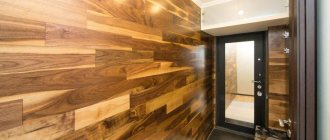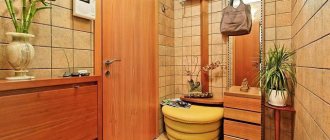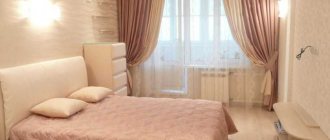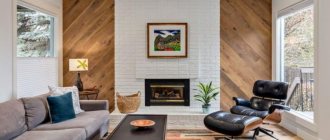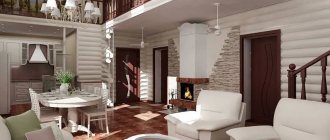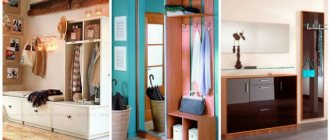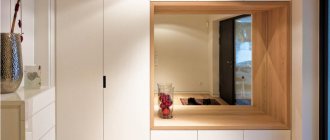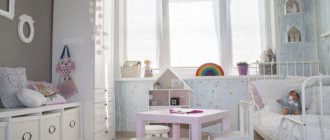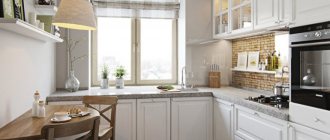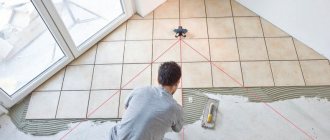5 Ratings: 1 (Yours: )
Renovating a hallway is no less important than finishing work in a living room or bedroom. There is usually less furniture here, but it is often difficult to arrange due to the small area or the specific shape of the room. To avoid having to act by trial and error, it is better to immediately draw up an accurate layout. This is not difficult and does not require special skills; the Interior Design 3D program is enough. Even a beginner can work in it. Read how to design a hallway in an apartment in our functional editor.
You can take one of the projects to simplify your work and get inspiration for your ideas. The files open in the Interior Design 3D program, and in it you can customize every element of the interior design.
- №1.
Bright corridor in a standard Khrushchev building - №2.
Small olive-colored corridor
Features of wall decoration in the hallway
The hallway is a kind of face of the house: it creates the first impression of it among guests. Therefore, it is important that the decor of the place is attractive. In pursuit of beauty, however, one should not forget about the purpose of the room, which imposes certain restrictions on the use of materials. To avoid having to constantly make repairs, the selected decor must have the following properties:
- Durability. Including resistance to abrasion and mechanical damage.
- Durability. It is optimal if the manufacturer guarantees a coating service life of at least 5-7 years.
- Easy to care for. Considering that the walls in the corridors are often dirty, the material should at least be resistant to wet cleaning. Ideally, it should be cleanable with a brush and the use of some detergents.
- Maintainability. It is important that the surface can be repaired. In this case, if a defect appears, it can be repaired, which is much cheaper and easier than replacing the entire surface.
- Safety. The material must be safe for the health of those nearby. In addition, fire safety must be taken into account. Do not use flammable or toxic coatings in the room where the entrance door is located. In the event of a fire, this could cost lives.
The color and texture of coatings can vary greatly. They are selected depending on the characteristics of the corridor in question. By combining materials, shades and textures, you can achieve the best results. Light shades will optically expand the space, while dark shades will narrow it. Clever use of patterns, lighting and the installation of mirrors can enhance the effect.
Wall covering
When choosing materials for walls, it is absolutely necessary to exclude the use of almost any paper or fabric wallpaper , since they are susceptible to moisture. Therefore, it is recommended to use brick, wood or stone panels.
Wall coverings can be either plain or with a pattern. If you want to save on wall coverings, then as an option you can cover the walls with plaster and paint them .
For example, one of the hits for several seasons has been Venetian plaster. This type is chosen mainly because it is more economical than panels, but at the same time creates an imitation of marble and other stone species.
Materials for decoration
The walls in the corridor or hallway can be finished with stone, decorative plaster, wallpaper, wall panels, made in the form of brickwork, or a combination of these materials.
Decorative plaster
Thanks to the textured, imitation and color properties of decorative plaster, amazing effects can be achieved. Textured surface with various patterns, ideal for any decoration style.
Fresco
A fresco is a unique, elegant piece. Compatible with any finish. Ready-made frescoes can be purchased in stores. To create a unique design, you can order the services of an artist.
Plastic panels
Plastic panels are very often used for cladding the walls of corridors. This material is budget-friendly and available in a wide range of designs and colors.
The interior walls of the corridor made of plastic panels can be made in any style. Covering walls with this material is quite simple and easy; there is no need to level or heavily prepare the walls.
Plastic panels can be wet cleaned, but it is worth remembering that they quickly fade when exposed to direct sunlight and are also easily damaged.
Dye
Painting the walls in the hallway is the cheapest and easiest option. A wide range of paints means you can choose any shade of color for your hallway walls. Usually choose warm, pastel colors.
It is worth noting that in order for the paint to adhere well to the walls, they must be well prepared and as smooth as possible, otherwise all the flaws on the wall will be visible.
Wallpaper
Allows you to create a really interesting corridor design. Washable vinyl, laminated or photo wallpaper will not only create a unique interior, but will also last a long time.
The photo shows a spacious hallway, the walls of which are decorated with wallpaper with bird motifs.
Flexible stone
It consists of a polymer slab covered with marble chips that successfully imitate natural stone.
Ceramic tiles
Tiles are commonly used in bathrooms and kitchens. But with the right choice, they will look good in hallways. A wide selection of colors and patterns allows you to create interesting styling. Anti-scratch, practical, durable, heat-resistant and water-repellent.
The material can be used under the floor or as wall cladding. Imitation wood, stone and leather are ideal for country or country house style.
Stone
Natural or artificial stone in the hallway looks very impressive. As with creating a brick wall, the walls can be finished with stone. Apply it not to one wall, but to several. The decoration should be in the form of small inclusions.
Stone fragments are usually placed around the front door, as well as in front of it. This stylistic move immediately attracts attention.
Laminate
Inexpensive, but very effective laminate, which has many positive qualities. Laminate on the wall in the hallway can be used as an insert, or you can decorate one of the walls.
Mosaic
A variety of complex compositions, patterns and images make it extremely easy to bring color and originality to your hallway.
The photo shows a hallway with a wall decorated with a gold mosaic pattern.
Stickers
A great way to add personality and style to your living room. A variety of stickers in bright colors not only create a positive visual effect, but also help hide imperfections on the walls.
The photo shows a hallway and wall in a lilac shade, decorated with a sticker in the shape of a tree.
Bas-relief
Bas-relief is an aesthetic that attracts attention. You can create your own bas-relief and get an unusual and interesting design.
Gypsum panels and porcelain tiles
In this project, the author used several materials at once: drywall, MDF and large-format ceramics. Communications are hidden behind the panels, and the slabs visually divide the long corridor.
Design: Anush Arakelyan. View the entire project
Project: Anush Arakelyan. View the entire project
Brick wall
A brick wall is a rather bold and bright solution in the interior. Products that imitate small bricks bring a special charm to the interior. Quite often, white trim is used in the hallway, which makes the room more expressive and unusual.
The photo shows a small corridor with a brick wall.
Art hanger
Metal rings are attached at equal distances around the perimeter of a large wooden or metal frame. A brightly colored cord or wire is pulled through them in a random order. This beautiful structure is then attached to the wall in the hallway in a well-lit area.
Hangers are hung on a stretched cord, on which clothes are hung. Such a hanger will allow owners to fully express their creative individuality.
Hall interior: 3 mandatory points
1 There must be a mirror.
There should be no mirror in the hallway. It is important to position the mirror correctly to optically enlarge the hallway. You can hang a mirror on one of the walls, scattering the space behind it. The mirror can also be placed on the sliding door of a wardrobe or on the front door. The mirror can also be framed to add variety to your interior design.
2 Comfortable furniture
In compact hallways, furniture should be functional and comfortable. The free space in a country cottage allows you to organize storage systems in the dressing room, so a small chest of drawers will be enough in the hallway to store various trinkets. For those who prefer to store outerwear and shoes in the hallway, there are spacious wardrobes to choose from. The interior will become lighter if the bulky structure is almost invisible. This effect can be achieved using recessed furniture or mirrored doors. Often storage areas give away handles, so to keep them secret, order a cabinet with a push up system, which allows you to open cabinets by pressing on its surface.
A bench or ottoman to sit on while you put on your shoes will add comfort to your entryway.
3. proper lighting
If you don't have access to natural light, you need adequate artificial lighting. You can use a combination of spotlights and pendant lights. For a large hallway decorated in a classic style, a large chandelier is ideal. A floor lamp on a chest of drawers or a wall sconce to create a more intimate atmosphere.
Furniture
In modern hallways it is customary to use a minimum of items.
- A sliding wardrobe, straight or corner, a shoe rack and a couple of poufs - this is quite enough to hide all your things and shoes.
- Built-in furniture allows you to save space in small rooms, but in spacious corridors you can use full-fledged sets.
- The best option for decorating a corridor is modular furniture; it is a stylish and practical solution. If necessary, you can quickly refresh the interior by simply swapping modules or purchasing a couple of new ones. Since the modules are produced in a whole series, it will not be difficult to replace old parts or supplement an existing set with something new.
Light design of the hallway of the room Beautiful design of the hallway of the room
Design of a small hallway
Designs for small vestibules do not make much sense. Functionality and precision come first. Therefore, only one selected decorative material will be used for finishing. No unnecessary complications.
Flowing wallpaper in a practical shade. Shades of gray or sand are ideal.
Masonry. No islands or complications. Simple and concise.
Wallpaper with coloring function. No patterns or ornaments.
The walls are painted in any neutral shade.
Liquid wallpaper takes first place for a reason. Its practicality is at the highest level.
A small hallway will force you to touch the walls, and an accident is bound to happen, resulting in dirty splashes on the walls. Liquid wallpaper copes brilliantly with these problems. They are durable, washable, and do not show minor dirt. Brick wallpaper has the same advantages, but is more difficult to decorate.
Paintable wallpaper is more practical than painting the wall itself. It is easy to stick on and can be darkened or repainted to a different shade at any time. Be simple and uncomplicated, without patterns or designs.
Paint is not practical in hallways. Especially in dark shades.
The fact is that walls are painted after priming, and this material is white. Therefore, any chips and scratches will be clearly visible. In addition, each touch leaves a slight mark, as if someone had rubbed it with an eraser. After a while there will be a lot of such traces, and only they give the corridor a chaotic look.
Overall, the idea is clear. Choose one type of material and one shade. No tricks are needed here.
Light or bright colors
A very common but effective option for visually expanding the hallway space is to paint the walls white or another light shade.
It is best to combine shades, for example: it is better to paint long walls in a lighter/brighter shade than short ones. This will make the corridor seem larger. Avoid overly intrusive colors or aggressive patterns.
Another good tip for making a quaint entryway feel more spacious is proper lighting. In most cases, there are no windows in the hallway, so it is necessary to install several light sources from different sides. This can be done using sconces, wall lights or LED strips.
Correct selection of furniture
Probably one of the most logical space-saving tips is to purchase prefabricated or narrow furniture. Practical furniture is not just a practical pouf that can be easily put away.
Multifunctional cabinets and shelves, hooks for clothes or hats, and elegant cabinets with hinged doors are just some of the options.
Another way to save space in the hallway is to use narrow or hidden-mounted appliances. It's best not to underestimate this method - when installed correctly, they can hold as much clothing as a regular closet.
And the last tip: using organizers and baskets in the hallway will not only increase space, but also get rid of chaos and clutter in the hallway.
Photo wallpapers and mirrors
Fashion is cyclical, and what once seemed beautiful and then lost popularity can become relevant again! This is the case with photo wallpapers - not so long ago they were considered unappetizing, but now they can bring depth and variety to the interior of a room.
Large mirrors will create an optical illusion effect and increase the space. You can also use shelves with a mirror or glass surface, which will reflect light and add sparkle to the room.
Lighting
The selection and installation of lighting fixtures in the hallway should be approached responsibly, because there are no windows or natural light. General principles:
- ●
It is better to distribute the light evenly along the corridor. It should not be too dim or too bright so as not to harm vision; - ●
The main interior should be combined with the lighting in the hallway; - ●
To save natural resources and your money, it is better to use energy-saving light bulbs and auto-off lamps; - ●
Hallway lighting is divided into local and main; it is important that they are combined and together create the ideal combination.
Lighting comes in the following types:
- ● Main light
- for example, this could be a chandelier located just below the ceiling. But keep in mind, they are only suitable for medium to large hallways. - ● Accent light
- for example, LED strip. This type of lighting is necessary to highlight certain parts of the interior and decor.
It is best to use diffused light
. To achieve this effect, you need sconces and wall lamps with a matte shade. With a suspended ceiling, you can direct the rays upward so that they reflect the light.
Examples of main lighting
For a large hallway
Increasingly, large modern hallways are found in cottages, detached houses or large apartments. Here the designer’s imagination is not limited.
According to modern style, it is necessary to have a closet in which, in addition to clothes, you can put a vacuum cleaner, extra pillows and blankets and many other trinkets.
For decoration you can use different colors and shades. For example, you can use dark colors, experiment with various accessories and decorate it with large, expensive decor that will emphasize the wealth of the owner.
It is important to remember that all the selected furniture will be comfortable, and its quantity will be optimal.
Other furniture
If there is free space in the hallway, install a small bench, pouf or chair. A good addition could be a table, a small chest of drawers or a bedside table.
Larger rooms can accommodate a whole set, but don't make the room too cluttered.
Cabinets
Modern hallways try to get rid of unnecessary or rarely used items as much as possible, and hide everything else behind beautiful and neat facades of storage systems.
The best way to do this is through your wardrobe. It is compact in size, does not require additional space to open the door and securely accommodates the mirror built into it.
Having a fairly large internal space, the compartments are ideal for storing small items of clothing: scarves, mittens, hats, outerwear, shoes, care products for all these things.
Hinged cabinets are less popular, but are still used quite often.
Mirrors
It's hard to imagine a hallway without a mirror. This is where the finishing touches are put on the look you've created, your overall appearance is assessed and the subtleties of your wardrobe are checked.
In large hallways, two mirrors are often installed, one opposite the other. This makes the space seem larger.
A mirror on a closet door looks great because it doesn't take up space on the wall or reflect clothes or shoes hanging on the shelves.
For a more interesting accent, mirror surfaces can be patterned or covered with a decorative matte pattern.
Lighting
Most lobbies do not have their own windows, so lighting is also an important issue.
Most often, several types of lighting are planned.
General lighting will illuminate the entire area, spot lighting will highlight certain objects (cabinets, mirrors, paintings) or areas.
Ceiling covering
It’s no secret that in design now everything strives for minimalism and simplicity, so for the ceiling it would be better to use a practical and simple structure. An excellent solution for ceiling covering in the corridor would be a suspended or self-leveling ceiling, as well as flat plasterboard.
It is worth choosing a ceiling covering based on the size of the room. For a small hallway, self-leveling ceilings with a glossy reflection are , which will visually increase the space. The use of multi-stage ceilings is not prohibited, if the space allows it - it should be free and open.
Hallway in a modern style: photos of mistakes
Let's start with the mistakes made when decorating the interior of the hallway. This is usually the most educational part. The photo itself will go first, and then below it will be a description of the error.
Is this mirror too small? But why is it so high? Apparently, the owners practice warming up by jumping rope before going outside. Enlarge the mirror and place it below.
The cabinet design is not bad, but it should be horizontally mirrored. Move the fenced high section further out and move the bench right up to the entrance. Otherwise, the entrance is too crowded. And if several guests arrive, how will they fit in such a cramped space? In fact of the matter. And they forgot about the mirror, like in most of the photos in this article.
There is space and no mirror - no problem. There was nothing stopping them from hanging a mirror to the right of the door or removing a few coat hangers.
Well, and our favorite hallway, no more comments.
Advantages and disadvantages of open hallways
In this option, there are no closets, and clothes are stored on a hanger. Underneath there is an open or closed shoe box. Spacious mezzanines are often placed above the hanger, allowing you to store seasonal items. This option is intended for equipping hallways of minimal size, both square and narrow, vestibule type. It is also possible to place open hallways in a small niche.
The design of the open hallway is very convenient for families with young children. A large amount of clothing can be placed on a hanger without interfering with each other.
Such hallways are similar to traditional hangers, known for many decades, which are remembered by the grandfathers and great-grandfathers of the owners. At the same time, you should constantly monitor the quantity and cleanliness of things located on the hanger. Items that are unnecessary for the current season should be stored in another place.
Photo of the walls in the hallway (interesting design ideas)
Design ideas
Decorative elements
In a small hallway, it is advisable to avoid additional decorative elements, as they overload the space. Just put some figurines and a mirror. If the size of the room allows, accessories will help give the space additional touches. A good option would be a painting - the size of the canvas depends on the size of the wall. It is important that all the main elements of the interior look proportional. That is, if there is a large wardrobe in the hallway, then a canvas measuring 60 by 40 will look appropriate. But this picture will look too wide against the background of the small size of the furniture.
Another important rule is the dosage of interior elements. There should be no more than two paintings on each wall. It is better to leave rooms with original wall coverings without additional decorations.
Square hallway
This classic entryway is easy to create, but just as easy to ruin if you mess up the design. It is important that the middle passage is always clear. On one side there should be a small closet, a chest of drawers and a shoe cabinet with a bench, and on the other there should be a wardrobe. Perfect symmetry and the absence of unnecessary details will reveal all the advantages of the room.
It is important that each element emphasizes the correctness of the square. This applies not only to furniture, but also to finishes and colors. If you decide to choose a contrasting color scheme, it should be replicated on both sides of the front door.
Selection of furniture for the hallway
When choosing furniture, remember that the hallway needs free space. Therefore, if the hallway area is small, it is better to avoid bulky massive cabinets and walls. Instead, choose cabinets with light-colored legs. Recessed furniture is another good idea. A built-in wardrobe will not clutter up the space and will provide plenty of storage space.
In addition, the hallway should have a small table for keys and trinkets, a seat for convenience, a clothes hanger, a cabinet for shoes and a mirror. All furniture can be decorated in one shade or create a harmonious ensemble.
How to choose a color
To make a small hallway seem larger visually, it is advisable to buy light-colored furniture. It can be white and its shades, light beige, light gray, slightly pinkish, bluish. There are options in which some parts are painted dark. Such furniture, even with a standard, in general, design, is more interesting in appearance.
It is desirable that the color of the doors and furniture match or there are at least elements with a similar color
When choosing a set for the hallway, it makes sense to find furniture in which at least some of the details will be the same color as the doors opening into this room. Then everything will look like a single ensemble. If your doors are dark, look for light furniture with elements in the color of the door.
A small hallway will look larger if the furniture has a slight gloss. Plastic-clad facades fit perfectly into modern, modern or high-tech styles. If you don’t like such trends, choose a classic design in one of the light colors. In general, when choosing a color, you need to keep in mind that the furniture in a small hallway should have a light shade.
Modern interior styles
Find out about the latest design trends with descriptions and photographs of fashionable hallways.
Classical
The laconic classic looks noble and emphasizes the taste of the apartment owners.
In this interior, raw elements are unacceptable, which are welcome in high-tech, modern or loft styles.
The classic style uses a light palette for walls, floors, ceilings and furniture, a choice of natural materials or their imitations, and an integration of ornaments including stucco, blacksmithing, etc.
High tech
High-tech, with its desire to remove everything unnecessary, is another suitable option for city life. However, many people find this style uncomfortable. One of the most unusual solutions that is suitable for hi-tech is to place flush-mounted neon lamps of different colors along the wall. This will definitely add variety to the interior.
Minimalism
Minimalism or eco-minimalism—with its penchant for uncluttered spaces—is ideal for any small space.
Original
Pastel colors may be the best option. However, to give the room a unique look, you can also create bright contrasts. Carefully arranging a variety of furniture that combines several colors can give the desired effect. For example, by decorating the walls with soft panels and installing bedside tables, you will turn your hallway into a cozy corner.
DIY wall decorations or custom wall murals can make your entryway feel more spacious and full of color. And fancy wall hooks, hangers, wall accessories with unusual decorations can fill the room with uniqueness, creating a special atmosphere.
You can lay a carpet with an original pattern. Paste the same motif on one wall and on the ceiling. High-quality wall panels and a mirror wall are ideal options for decorating the exterior of the hallway.
Unique shades of cabinet fronts, doors, floors or ceilings in a checkerboard style will make even your wildest fantasies come true. Plus, a deep, slightly solid color will leave an unusual mark on your guests' first impression.
Provence
If the room should be decorated in Provence style, then follow these rules:
- Use natural finishing materials or their analogues.
- Keep your color scheme light by using lavender, cream, pale blue and other pastel colors.
- Use vintage accents and handmade accessories for decor.
Loft
The interior, designed in a loft style, looks raw and brutal. But it does not have to consist only of brick walls. The space can be decorated with other interesting accents.
Organizing a hallway in an apartment does not require large expenses, since natural brick, concrete and wood with an antique effect are allowed in the decoration.
The color range is not limited to dark shades. You can also use a light palette with contrasting details.
Art Deco
Considered luxurious and somewhat artsy, this style allows for bolder ideas and custom details. It can have several levels of ceiling, stucco, textured walls and so on.
If you are planning to decorate a room in an art deco style, you will have to give up budget furniture and cheap decor.
It should contain only expensive materials, for example:
- Ceramic tile.
- Varnished wood.
Scandinavian
This style is built on an abundance of free space. Therefore, only compact furniture is used. The accent color is white combined with pastel colors.
In the Scandinavian direction, elements of high-tech, loft or modern minimalism are allowed.
Flooring
As mentioned above, the material from which the floor is made must be strong and durable. But at the same time, the appearance of the flooring should in no case yield to modern trends.
Now there are several suitable finishing materials that will simultaneously withstand large items, will not receive any damage during use, and are easy to clean. The most suitable material with all such functions is rightfully ceramic tiles and porcelain stoneware .
Laminate, parquet or even linoleum will look good , but you should still be careful with the latter, because linoleum is softer and more flexible in its properties, unlike the others, in this regard, if you decide to save on such material, you can significantly worsen the interior of your entrance room, since it certainly does not fulfill any of the functions intended for the floor coverings of the corridor.
An original solution would be a combination of several materials. For example, you can tile the entrance area , and then lay carpet.
Color spectrum
Since there are no windows in a standard hallway, bright colors are preferred. This could be white, beige or bolder colors such as blue, burnt orange, grey, lime green, pink or purple. Shades of brown, from deep rich to light coffee, look good as accents.
Accent colors should not make up more than 15-20% of the interior color palette. However, designs on finishing materials and textiles are acceptable. Such details will help create a more interesting organization of space.
Corner hallways
It is impossible to create a beautiful hallway in an apartment without saving space. This purpose is served by small-sized corner structures that allow you to organically use the available space, and their absence of protruding parts and corners will not interfere with movement around the apartment.
